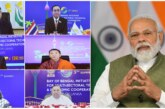Freshwater is very essential for the survival of human beings, animal life as well as vegetation and without it the planet would be a barren wasteland. The supply of water is finite, but demand is rising rapidly as population grows and as water use per capita increases. The planet earth is endowed with finite supply of fresh water, bulk of which is stored in aquifers, surface waters and the atmosphere. The oceans are sometimes mistaken for readymade sources of water. However, the quantum of energy required to convert saline water to potable water is prohibitive today, and it explains why only a very small fraction of the world’s water supply is obtainable from desalination.
The current water crisis rocking the globe has several principal manifestations. Currently, over 1.1 billion people around the globe have inadequate access to safe drinking water. Besides, groundwater over-drafting has resulted in diminution of agricultural yields. Apart from the overuse of water resources causing damage to biodiversity, the possibility of regional conflicts over scarce water resources culminating in warfare cannot be ruled out under the prevalent circumstances.
Viewed in a historical perspective, the manifestations of the water crisis have been less obvious, but 20th century levels of human overpopulation have unfolded the availability of limited quantity of fresh water. Undoubtedly drought dramatizes the underlying shaky balance of safe water supply; nevertheless it is the hasty actions of humans that have exposed the human population to the destruction of major droughts.
According to United Nations estimates, apart from 1.1 billion people who are without adequate drinking water, 2.6 billion people are without adequate water for sanitation. Both these issues are intertwined, since, without water for sewage disposal, cross-contamination of drinking water by untreated sewage is the key adverse upshot of insufficient safe water supply. Accordingly, disease and significant deaths arise among the people using contaminated water supplies. These effects are predominantly pronounced among the children in underdeveloped countries, where 3900 children per day die of diarrhea alone.
Besides, waterborne diseases and the lack of sanitary domestic water facilities are one of the foremost causes of death throughout the world. For children under age five, waterborne diseases are the leading cause of death. At any given time, half of the world’s hospital beds are occupied by patients suffering from waterborne diseases. According to the World Bank, 88 percent of all diseases are caused by unsafe drinking water, inadequate sanitation and poor hygiene.
There is little consolation in the fact that these deaths are generally considered preventable because the situation is considerably more complex, as the Earth is beyond its carrying capacity with respect to available fresh water. The logic of technology as a panacea seems untenable, particularly in view of the fact that the costs of technology presently exclude a number of countries from availing themselves of these solutions. However, sustainable solutions must engage each region in balancing population to water resource and in managing water resources more carefully.
Risks to Biodiversity
Adequate freshwater resources are almost a sine qua non for the very survival of vegetation and wildlife. Sustainable water supply is equally essential for marshes, bogs and riparian zones. Diminishing levels of water availability have put forests and other upland ecosystems at risk. At the same time other areas have suffered reduced productivity from steady decrease in freshwater inflow, as upstream sources are diverted for human use. In seven states of the U.S. over 80 percent of all historic wetlands were filled by the 1980s, when Congress acted to create a “no net loss” of wetlands. An extensive loss of wetlands has also taken place in Europe resulting in loss of biodiversity. Many bogs in Scotland are reported to have been drained or developed through human population expansion.
A massive transformation occurred on Madagascar’s central highland plateau that eliminated almost all the heavily forested vegetation in the period 1970 to 2000. The slash and burn agriculture eliminated about ten percent of the total country’s native biomass and converted it to a barren wasteland. Overpopulation and the necessity to feed poor indigenous peoples are reported to have caused these effects. However, the adverse effects included widespread gully erosion that in turn produced heavily silted rivers that “run red” decades after the deforestation. This removed a bulk of usable fresh water and also caused destruction to much of the riverine ecosystems of various large west-flowing rivers. Several fish species have been driven to the edge of extinction and some coral reef formations in the Indian Ocean are effectively lost.
Issues Involved
Population growth, wasteful or poorly planned use, and water grabs by nations seeking to develop their irrigation systems, industry and domestic water supplies generally exacerbate the paucity of safe fresh water. The water crisis also entails the potential of becoming a flashpoint for international tensions, and perhaps war.
In theory, some 34,000 cubic kilometres of freshwater are available globally for human use every year. If evenly distributed this would provide each person with roughly 8,000 cubic metres of water per year (based on the population in 2000). This amount would be enough to meet human needs, if freshwater were evenly distributed. But available freshwater supplies are not distributed evenly around the globe, throughout the seasons, or from year to year. Two-thirds of the world’s population – around 4 billion people – live in areas receiving only one-quarter of the world’s annual rainfall.
Throughout much of the developing world the freshwater supply comes in the form of seasonal rains. Such rains run off too quickly for efficient use, as during the monsoons in Asia. India, for example, gets 90 per cent of its annual rainfall during the summer monsoon season, which lasts from June to September. For the other eight months the country gets barely a drop.
Pollution of rivers and lakes reduces accessible freshwater supplies. Each year roughly 450 cubic kilometres of wastewater are discharged into rivers, streams and lakes. To dilute and transport this dirty water before it can be used again, another 6,000 cubic kilometres of clean water are needed – an amount equal to about two-thirds of the world’s total annual useable fresh water runoff.
The amount of water that people use depends not only on basic needs and how much water is available but also on levels of urbanisation and economic development. Withdrawals of water have grown to meet demand for all types of use – for irrigated agriculture, industry, and municipal (household) purposes. As the world continues to urbanise at rapid rates, the demand for potable water for municipal use is expected to soar, out pacing the capacity of most cities to provide it.
Water shortages in many countries are created by burgeoning population and rising demand per capita. Globally, the annual population increase of nearly 80 million per year implies an increased demand for freshwater of about 64 billion cubic metres a year – an amount equivalent to the entire annual flow rate of the Rhine River.
A country is said to experience water stress when annual water supplies drop below 1,700 cubic metres per person. When supplies drop below 1,000 cubic metres per person per year, the country faces water scarcity for all or part of the year. Malin Falkenmark, a Swedish hydrologist, developed these concepts to gauge current and future water needs and to measure scarcity.
Population Action International (PAI) adapted Falkenmark’s concepts to calculate water stress and scarcity in 1995, with an update in 1997 and projections for 2025 and 2050. The results are startling: in 1995, PAI estimated that 31 countries, home to nearly half a billion people, regularly faced either water stress or water scarcity. In 2025, 48 countries containing about 3 billion people will face water shortages. By 2050 the figures will be 54 countries containing 4 billion people, or 40 per cent of the projected world population of 9.4 billion. More recent estimates underscore how bad the situation has gotten since 2000. UNEP, in its Global International Waters Assessment in 2006, claims that by 2025, 1.8 billion people will already be living in conditions of acute water scarcity, while two thirds of humanity (over 5 billion) will be living in countries experiencing water stress (shortages for all or part of the year).
The fact that the UN’s latest median projection for world population in 2050 is lower, at around 9.1 billion does not significantly alter this scenario. Still, national level calculations of water availability have serious shortcomings. In a number of countries, the overall access to water on a national level may be above the water stress or scarcity level. But taking a river basin perspective reveals that parts of many water-rich countries are running out of water. On a country-wide basis, for instance, the United States is relatively water-sufficient at 8,838 cubic metres per person per year. Yet the crowded Colorado River Basin has only slightly over 2,000 cubic meters per person per year, and the Rio Grande River Basin registers well within the water scarce category at 621 cubic meters per person per year.
With a view to address this shortcoming, the Pilot Analysis of Global Ecosystems, carried out by the World Resources Institute, calculated water availability and population pressures by river basin. Their analysis is even more sobering. This approach indicates that currently 2.3 billion people, or 41 per cent of the world’s population, live in water stressed areas. Of this total, 1.7 billion live in water scarce areas, with less than 1,000 cubic metres per person per year.
According to the PAGE analysis, by 2025, the number of people suffering from water stress or scarcity could swell to 3.5 billion people, or 48 per cent of the world’s projected population. Moreover, 2.4 billion of them are expected to live in water scarce regions.
While projections are not predictions, these figures point to the need for urgent attention to issues of stabilising population growth and using water resources sustainably.
The 20 countries of the Near East and North Africa face the worst prospects. In fact, the Near East “ran out of water” in 1972 in the sense that, since then, the region has withdrawn more water from its rivers and aquifers every year than is being replenished.
Currently, for example, Jordan and Yemen withdraw 30 per cent more water from groundwater supplies every year than is replenished, and Israel’s annual water use exceeds the renewable supply by 15 per cent. Inevitably, this means that water tables are falling and aquifers are slowly being sucked dry. The enormity of the water crisis can be gauged from the fact that in the early months of 2004 Israel signed a deal with Turkey to ship 50 million cubic metres of water a year, for 20 years,from the river Manavgat in Anatolia, in return for arms.
Africa also faces serious water problems. Currently, some 206 million Africans live in water stressed or water scarce countries. By 2025 the number will rise to about 700 million, as population continues to grow rapidly. Of these, roughly 440 million will live in countries with acute water scarcity (less than 1000 cubic metres per person per year).
If calculations of water stress and water scarcity were made regionally instead of nationally, parts of many other countries would be considered to face shortages.
China, for example, has 22 per cent of the world’s population but only 7 per cent of all freshwater runoff. China’s freshwater supplies have been estimated to be capable of supporting 650 million people on a sustainable basis – only half the country’s population. Despite periodic flooding, particularly in the southern part of the country, China faces chronic water shortages in the northern part.
At the start of the millennium, some 400 of 600 major Chinese cities were suffering from severe water shortages. Of these, 30 cities in northern China, including Beijing, will face long-term shortages severe enough to limit their economic development. Elsewhere, in rapidly growing cities such as in Bangkok, Dhaka, Jakarta, Lagos, Manila, and New Delhi, freshwater is so short that water theft has become widespread.
Competition becomes intense when water supplies are scarce. Tensions are particularly high in water-deficit areas where population pressures, urbanisation, and development needs collide to create demand for freshwater beyond nature’s available supply. Countries that face tensions over water include Belgium, Poland, Singapore and the United States. In the western United States, for example, farmers demanding more irrigation water for their crops are competing with fast-growing urban areas demanding more water for municipal uses.
Already, China is practising what water expert Sandra Postel calls the “zero sum game of water management” – when authorities increase water supply to one user by taking it away from another. China’s Yellow River is a classic example of this. The river is so over-used that, for an average of 70 days a year for the past decade, its waters have dried up before reaching the Bohai Sea. Crops have withered in the once rich delta so that upstream factories and farms could take all the water.
The world’s 6.7 billion people are already appropriating just over half of all the accessible freshwater contained in rivers, lakes, and underground aquifers. By 2025 humankind’s share will be at least 70 per cent – a conservative estimate that reflects the impact of population growth alone. If per capita consumption of water resources continues to rise at its current rate, humankind could be using over 90 per cent of all available freshwater by 2025.
Future Outlook
Many countries face difficult choices as they are caught between growing demand for fresh water on one hand and limited and increasingly polluted supplies on the other. Finding solutions requires responses at local, national, and international levels. Nothing short of a Blue Revolution in water management can prevent the coming crisis.
Community led initiatives to manage water resources better can help urban dwellers gain access to safe, piped water supplies, improved sanitation and public health. Despite considerable efforts in the last two decades, the latest assessment by WHO/UNICEF finds that 2.6 billion people are still without an acceptable means of sanitation, while 1.2 billion do not have access to clean piped water. In any case the finite nature of the water resource must be acknowledged if the world is to achieve a better balance.
Year 2025 forecasts state that two thirds of the world population will be without safe drinking water and basic sanitation services. Construction of waste water treatment plants and reduction of groundwater over-drafting appear to be obvious solutions to the worldwide problem; however, a deeper look reveals more fundamental issues in play. Wastewater treatment is highly capital-intensive, restricting access to this technology in some regions; furthermore the rapid increase in population of many countries makes this a race that is difficult to win. As if those factors are not daunting enough, one must consider the enormous costs and skill sets involved to maintain wastewater treatment plants even if they are successfully developed.
Reduction in groundwater over-drafting is usually politically very unpopular and has major economic impacts to farmers. Moreover, given the population level at present, this strategy will necessarily reduce crop output, which is something the world can ill afford.
At more realistic levels, developing countries can strive to achieve primary wastewater treatment or secure septic systems, and carefully analyse wastewater outfall design to minimize impacts to drinking water and to ecosystems. Developed countries can not only share technology better, including cost-effective wastewater and water treatment systems but also in hydrological transport modeling. At the individual level, people in developed countries can look inward and reduce over consumption, which further strains worldwide water consumption. Both developed and developing countries can increase protection of ecosystems, especially wetlands and riparian zones. These measures will not only conserve biota, but also render more effective the natural water cycle flushing and transport that make water systems more healthy for humans.



